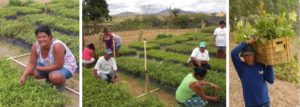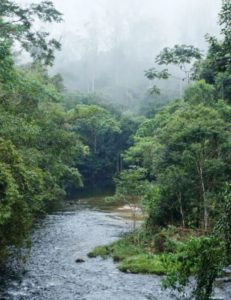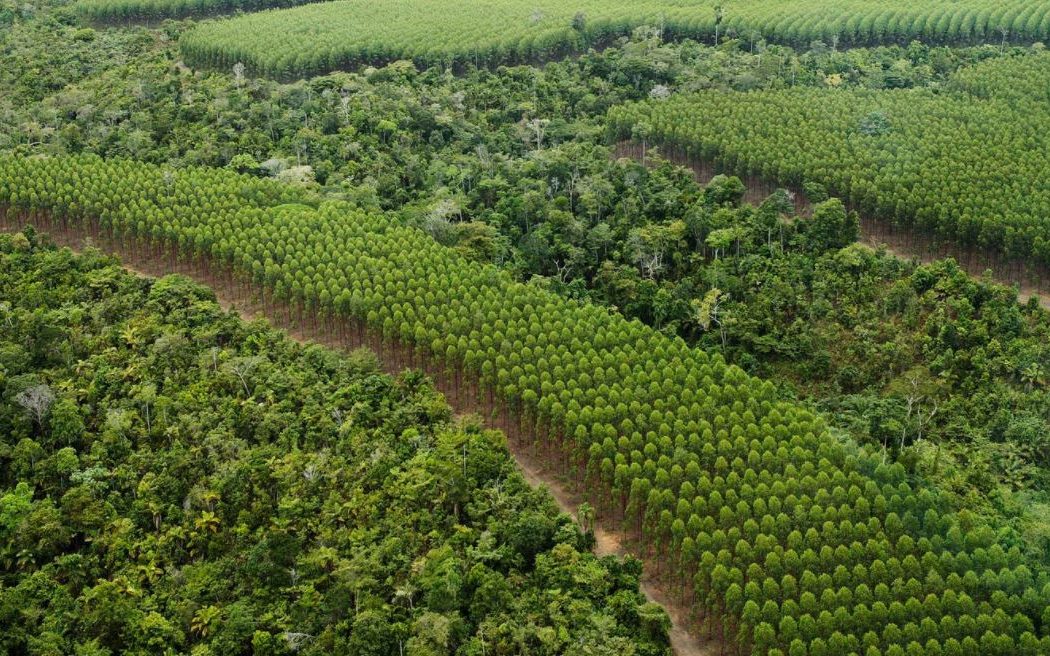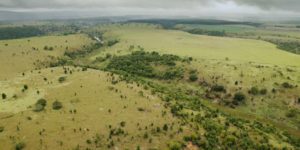When one hears bad environmental news from Brazil, it usually involved either dams or large landowners, such as cattle ranchers or plantation owners. The bad news from the dam builders and cattle ranchers continues, but there’s now some good news regarding plantation owners. Some of them are banding together to help restore the countries endangered, biodiversity-rich Atlantic forests.
When the Portuguese landed in Brazil in 1500, they would have been met by a vast wall of forest. To the sailors tracing the length of coast and the first explorers setting out into the interior, it must have seemed endless.
The Atlantic forest—Mata Atlântica in Portuguese—once extended the entire length of Brazil’s east coast, reaching inland into Argentina and Paraguay. It covered an area of over a million square kilometers – more than 10 times the size of the country the colonizers had come from. But over the centuries, the trees were cut down in their billions.
First came the rush to harvest brazilwood – a tropical hardwood that yields a bright red pigment perfect for dying cloth. The forests of the “land of brazilwood” were plundered to meet the insatiable demand for the red dye back in Europe. By the middle of the 16th century, supplies were dwindling, but brazilwood exports had been overtaken by a different commodity: forests were cleared to make way for sugarcane plantations as Brazil became the world’s largest sugar producer.
Coffee followed, then cocoa and cattle, while more trees were felled to supply a growing nation with timber and charcoal. Livestock ranches, fields of crops and sprawling cities like Sao Paulo and Rio de Janeiro sprang up where the rainforest once stood. During the second half of the 20th century, the pace and scale of deforestation grew rapidly. Five hundred years after the first European settlers arrived, just 7% of Brazil’s Atlantic forest remained.
Yet these small, scattered fragments still harbour some of the richest biodiversity on the planet. Here, some 450 tree species can be found in a single hectare, and more than half of them exist nowhere else on Earth. Of the 20,000 plant species so far recorded – around 8% of the global total – 8,000 are unique to the region. Other endemic species include 282 types of amphibian, 144 birds and 72 mammals, including 22 primates like lion tamarins and woolly spider monkeys.
And it’s not just wildlife that depends on what remains of the Atlantic forest. In a region of growing water stress, the forest supplies water for some 60% of Brazil’s population – 120 million people. It’s a buffer against soil erosion, and sequesters 2 billion tonnes of carbon dioxide – more than four times Brazil’s annual emissions. Meanwhile, many of the region’s indigenous inhabitants, the Tupi and the Guarani, still depend on their ancestral forest and its resources for their livelihoods.
 Despite increased legal protection in recent years, urban and agricultural expansion continues to chip away at the forest, with around 20,000 hectares lost each year. Squeezed into smaller spaces and cut off from neighbouring populations, the region’s extraordinary biodiversity is under intense pressure: almost 148 vertebrate species – 104 of them endemic – are listed as Critically Endangered, Endangered or Vulnerable on the IUCN Red List. Most of these exist outside official protected areas.
Despite increased legal protection in recent years, urban and agricultural expansion continues to chip away at the forest, with around 20,000 hectares lost each year. Squeezed into smaller spaces and cut off from neighbouring populations, the region’s extraordinary biodiversity is under intense pressure: almost 148 vertebrate species – 104 of them endemic – are listed as Critically Endangered, Endangered or Vulnerable on the IUCN Red List. Most of these exist outside official protected areas.
The arrival of the pulp and paper industry and their eucalyptus plantations into this landscape could have proved the final straw. But over the last two decades, these companies have been doing something different. They didn’t follow the pattern of deforestation set over the previous five centuries. Instead, they began to restore the forest.
New Generation Plantations (NGP) participants Fibria, Stora Enso, Suzano and Veracel all have plantations within the Atlantic forest biome, managing more than 2 million hectares of land between them. Around half of this area is planted with eucalyptus, almost all of it on former grazing land that had become heavily degraded. The rest is set aside for conservation. And it’s here that the Atlantic forest is making a comeback.
According to Brazil Forest Code, landowners in the region need to preserve natural vegetation on 20% of their land (“legal reserves”) as well as in “areas of permanent protection” designed to maintain ecosystem integrity – as buffers around water courses or to prevent erosion on steep slopes, for example. While violations of the Forest Code are commonplace in other sectors, forest certification schemes like FSC provide assurance of legal compliance – and go further by requiring companies to identify and manage areas of high conservation value.
 In many cases, the set-aside areas are able to regenerate naturally – particularly when they adjoin existing fragments of native forest. Other parts, though, are too severely degraded for that to happen. Here, the companies are using their silvicultural expertise to actively replant the rainforest.
In many cases, the set-aside areas are able to regenerate naturally – particularly when they adjoin existing fragments of native forest. Other parts, though, are too severely degraded for that to happen. Here, the companies are using their silvicultural expertise to actively replant the rainforest.
Veracel, for example, planted its first 207 native tree seedlings in 1994. Since then, it has planted more than four million seedlings, covering 6,099 hectares. Restoration areas are carefully chosen, the main objective being to create corridors linking fragments of existing forest, enabling wildlife to move around to feed and breed. So far Veracel’s restoration efforts have restored connections between more than 65,000 small, isolated patches of forest. Links have also been re-established between Estação Veracel – a 6,000 hectare nature reserve owned by the company which has become a centre for education and research – and two tribal reserves belonging to Pataxó people. Pataxó leaders report seeing more armadillos and tapir, along with game species like catitu (a kind of wild pig) and paca (a large rodent).
Satellite monitoring demonstrates the changes that have occurred in the ten municipalities where Veracel operates since the company was first established in the 1990s. Images from 1990, 2007 and 2013 show a transformation from a pasture environment to a mosaic of plantations and forest in various stages of succession, with the area of native vegetation increasing by almost 12,000 hectares.
Fibria, meanwhile, has invested some R$80 million (US$25 million) over the last five years in restoring some 16,000 hectares, mainly in the Atlantic forest but also partly in the neighbouring Cerrado savannah. Its long-term goal is to restore 40,000 hectares by 2025. Restoration on this scale is no easy task, especially in a forest with so many tree species: to help meet the need for seedlings for planting, the company has helped set up 20 community-run tree nurseries. As well as supplying some 1.8 million seedlings each year, these provide an important income in rural areas where jobs are scarce.
 But while forest restoration brings undoubted environmental and social benefits, why should a business devote significant resources to it? According to Fibria, improving the health of the surrounding ecosystem directly improves the productivity of its eucalyptus plantations. A key reason for this is the improved quality and availability of water resulting from the developing vegetation cover. Suzano, which is in the process of planting over 3,400 hectares of native species in the state of São Paulo, also points to water availability as an important advantage of forest restoration. Additional benefits it cites include soil protection and pest control: while monocrop plantations are vulnerable to pest infestations, having native forests alongside encourages natural predators. That means better plantation health and less need for costly and potentially harmful pesticides.
But while forest restoration brings undoubted environmental and social benefits, why should a business devote significant resources to it? According to Fibria, improving the health of the surrounding ecosystem directly improves the productivity of its eucalyptus plantations. A key reason for this is the improved quality and availability of water resulting from the developing vegetation cover. Suzano, which is in the process of planting over 3,400 hectares of native species in the state of São Paulo, also points to water availability as an important advantage of forest restoration. Additional benefits it cites include soil protection and pest control: while monocrop plantations are vulnerable to pest infestations, having native forests alongside encourages natural predators. That means better plantation health and less need for costly and potentially harmful pesticides.
These individual company efforts are part of a much larger vision – the Mata Atlântica Restoration Pact, of which Fibria, Suzano and Veracel are active members. Launched in 2009, the Pact’s mission is to restore 15 million hectares (37.5 million acres) of Atlantic Forest by 2050, including a target of 1 million hectares by 2020. It brings together more than 260 members, including NGOs, businesses, government agencies and research institutions.
NGP participants have been closely involved in researching, developing and disseminating guidelines and best practices for Atlantic rainforest restoration, and providing technical and financial assistance to NGOs and community cooperatives involved in restoration activities. They have also developed an integrated system for monitoring biodiversity, which supports better landscape-scale planning to improve connectivity between species. This sort of collaboration will be crucial in enabling ecologically coherent and economically viable forest restoration to take place on such an ambitious scale – in the Mata Atlântica, and beyond.
All photos courtesy of New Generation Plantations.


